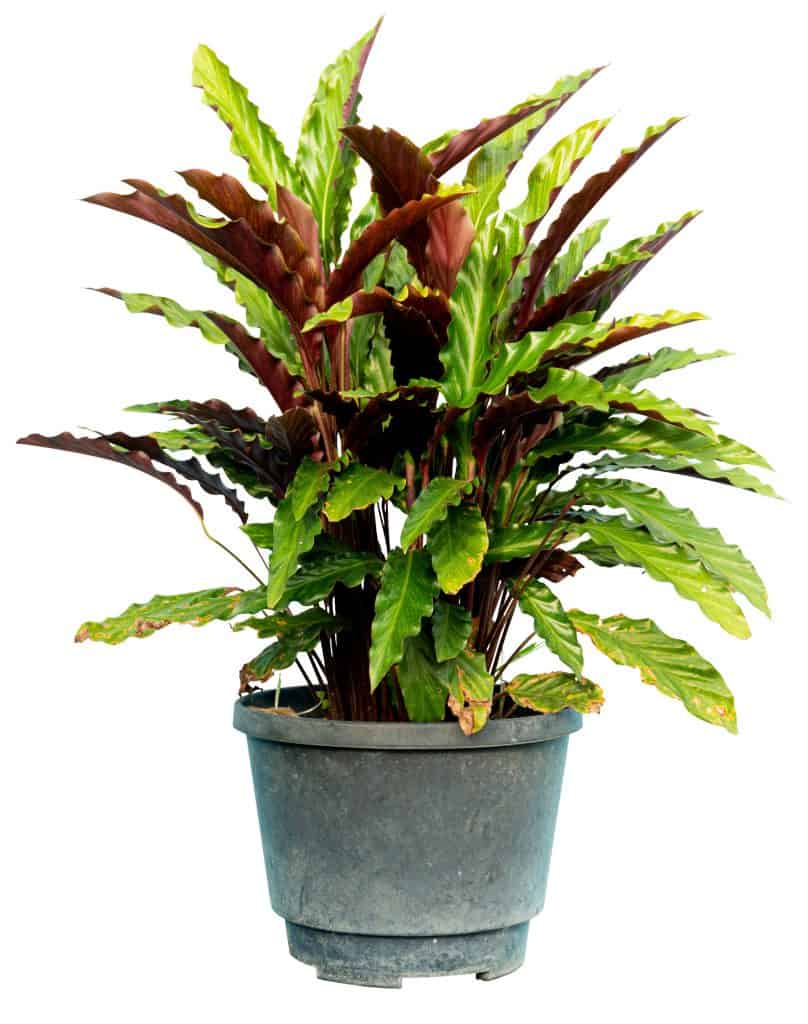Calathea Rufibarba is part of the Marantaceae family, and it originates from the Rainforest in Brazil. Rather unusually for a calathea, the green leaf tops are smooth, whereas the maroon undersides of the leaf are velvety with little hairs on them. This has led many affectionate gardeners to give it nicknames such as “the fuzzy/ furry feather Calathea,” “velvet Calathea,” “furry Calathea,” and many more. Aesthetically, Calathea Rufibarba makes an amazing addition to any houseplant collection by adding some color that will stand. This plant has long, slender, and wavy leaves that are light green when young. As the leaves grow older, they transition into darker green upper side and maroon to burgundy. The stems of Calathea Rufibarba are long and slender and are burgundy in colour as well. During the blooming season, large yellow flowers can appear under the leaves.
One interesting fact about Calathea Rufibarba is that its leaves move during the night. The moving of the leaves in this manner is called nyctinasty. The general purpose of the movement of foliage with all plants is to capture the light. During the day, the Calathea Rufibarba leaves drop and assume a more horizontal position to get more light. The green part of the leaf faces the source of light. What actually makes the leaves close up at night is up for debate. There have been many hypotheses over the years as to what causes this movement, from conserving temperature to conserving nutrients, but not one clear answer has been found yet.
For all the pet lovers, rest assured since Calathea Rufibarba is considered non-toxic to pets and humans.
Calathea Rufibarba Care
The Calathea Rufibarba is easy to care for as long as you follow some easy tips:
- The soil must be kept slightly moist and the plant needs to be kept out of direct sunlight.
- The Calathea Rufibarba is very draft sensitive. It will suffer from cold damage if he is placed in a draughty spot. Keep him away from any open windows or draughty hallways.
- To promote growth, use our fertiliser every 4 weeks in the spring and summer months. Always dilute to a quarter strength.
- Always water and mist with filtered water. Harsh chemicals found in tap water will cause the leaves edges to brown.

The Calathea Rufibarba is mainly cared for as an indoor plant in all mainland Europe; this plant does not like the cold weather and would suffer outdoor in the Winter! In terms of temperature, Calathea Rufibarba prefers temperature around 65°F to 90°F / 18°C to 30°C. It can tolerate temperatures slightly below 65°F / 18°C but will eventually suffer at lower temperatures. However, if the climate allows it, the Calathea Rufibarba can be cared for in gardens and it is not too complicated, provided the plant has all its needs met. Firstly, place the Calathea Rufibarba in shade or filtered light. The colorful markings will fade in direct sunlight. Allow 18 to 24 inches between plants. Water frequently to keep the soil moist, but never soggy, especially during hot weather. Water at soil level to avoid bacterial and fungal diseases. Similarly, avoid watering in the evening. Calathea Rufibarba will need feeding three or four times between early spring and fall, using a good quality, balanced fertilizer.
Calathea Rufibarba enjoys the same rules when growing indoors. Calathea Rufibarba ideally needs bright indirect light, but no direct sunlight.
Despite needing a lot of diffused light, your Calatahea Rufibarba will survive in a shadier area too. Calathea Rufibarba’s ideal soil is well-draining so to avoid soggy roots. To achieve the perfect balance between water-retaining and well-draining soil make your own mix or select a bagged mix that specifies Calatheas on the package. You can also make you own, by mixing equal parts of potting soil, compost, coconut coir and vermiculite or pearlite. The compost and coconut coir will retain water while the vermiculite and perlite will give enough space between soil particles for excess water to drain.
Watering Requirements
Calathea Rufibarba is extremely picky on how much water it needs! It needs lots of moisture, but don’t let the soil get too soggy. Alas, Calathea Rufibarba does not enjoy receiving too little attention. That is, never let their soil dry out more than an inch from the top. Calathea Rufibarba is no exemption to the rule of dramatic calatheas preferring filtered water. The minerals in tap water can negatively affect the leaves of the plant. Burnt tips and leaf edges may be a sign of mineral burn. If your tap water is heavy on minerals your plant might not like that at all. The pot you use will also affect your watering routine. Terra cotta pots are porous while plastic ones are not. This only means that moisture will escape the system faster in a terra cotta pot than in the plastic pots.
Humidity
As a rule of thumb, Calathea Rufibarba needs a lot of humidity, like they would normally get in their natural habitat, the Rainforest. It is best if the humidity is over 50%. It will tolerate periods with lower air humidity, however if the humidity is too low for too long, you will witness the tips of the leaves drying up, leaves drooping and the plant generally looking unwell and a bit dramatic. If you live in a home with a lower than ideal air humidity and would like to ensure that the plant receives adequate humidity, place your Calathea Rufibarba in the kitchen or the bathroom. The humidity levels are usually high in those rooms and if the light is also right, your calathea Rufibarba will be very happy there!

Propagating Calathea Rufibarba
Calathea Rufibarba propagation of the plant should be done via root division during repotting (which should typically be done during the beginning of the growing season- spring or early summer).
How to Repot Calathea Rufibarba
When you’re repotting your Calathea Rufibarba, simply shake off the excess soil and divide the plant at the roots and stems. If you have a larger plant, then you can even divide your plant into three, four, or five, plants.
If you need to repot your Calathea Rufibarba, will need a new pot that is a few inches bigger than the one it’s currently in with proper drainage, appropriate soil mix, and water. Make sure the pot is only a couple of inches bigger because your houseplant will suffer if it has too much space. Here is how to do it in simple steps:
- Firstly, water your plant the day before to facilitate removing the plant from its current home.
- Then pull it out from the base. Once the plant is out of the smaller pot shake the roots gently, so they untangle.
- Add more soil mix to the container so it goes up to about halfway. Next, use your hand to create a small space in the centre to accommodate the roots.
- Place the Calathea in its new home and fill the rest of the pot with soil. Gently press down on the top of the soil or tap the bottom of the top on the ground so the soil settles.
- Finish off by watering thoroughly and then getting rid of the water from the dish below.
Calathea Rufibarba will typically need repotting into a larger container every year or two, depending on growth conditions and the like. As a general rule, Calathea Rufibarba is a slow grower and will only reach about 24 inches in height (60cm).
Calathea Rufibarba Problems
Generally, if you maintain high humidity, you should not have problems with pests. Calthea Rufibarba is susceptible to scale and spider mites, especially when stressed (from under- watering, not receiving enough humidity or rootbound). Search for what the undelaying cause might be and treat spider mites using insecticidal soap. Scale can be treated with neem oil.
Keep an eye out for the following very common problems when taking care of Calathea Rufibarba:
Curling leaves
The curling leaves are a sign that Calathea Rufibarba is suffering from the cold. Have a look around the home to make sure that the plant is not close to any windows, radiators or doors that could be causing draughts.
Leaves turning yellow
Yellow leaf occasionally is natural, as leaves die off, they will become yellow (usually leaves at the bottom of the plant). Yellowing leaves in Calathea Rufibarba are also a sign of overwatering. You can remove this leaf by cutting the stem at the base of the plant. Reduce his watering schedule especially in the winter months.
Leaves with brown edges
The brown edges could be caused by a variety of things. The Calathea Rufibarba is sensitive to hard water which could be causing the leaves to brown. Use filtered or rainwater moving forward. Also, lack of humidity levels can be a cause. Very occasionally the brown tips could be from over fertilising, it is good to note that Calathea’s roots are very sensitive. Always dilute a generic houseplant fertiliser.
Drooping leaves
Leaves drooping at a certain part of the day is part of its natural movement cycle. However, if the leaves on the Calathea Rufibarba are constantly pointing down and drooping – your plant is most likely needing a drink.
Where can I find Calathea Rufibarba for sale?
While finding Calathea Rufibarba from local stores may not always be easy, they are often available for sale from online plant stores. In most stores, prices ranging from 12 to 20 USD.
